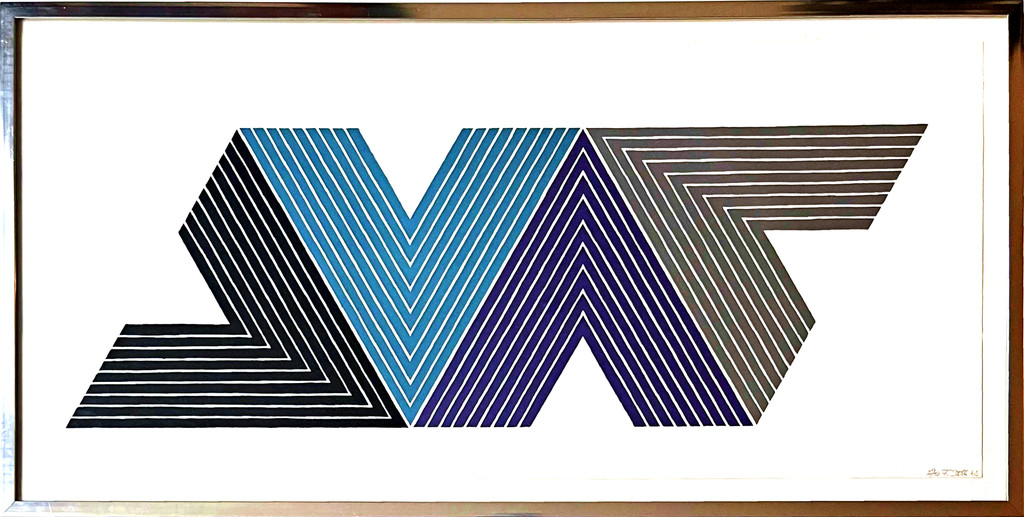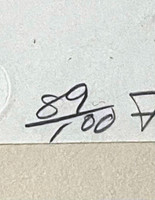
An Educated Collector is Our Best Client
In business for nearly two decades, we are a well established, popular contemporary art boutique specializing in expertly chosen, blue chip prints, multiples, uniques, books, ephemera and merchandise at different price points, with a focus on the secondary market. Please click on the "Contact Us" button at the bottom of this page for questions about any work, pricing and/or to arrange to visit our showroom/gallery - located in between Manhattan's Flatiron and Chelsea Flower Districts.
Description
Frank Stella
Empress of India I (Axsom 27, Gemini 81), 1968
Lithograph in colors with varnish on Lowell paper
Signed, dated & numbered 89/100 in pencil, lower right. GEMINI G.E.L. blind stamp & embossed copyright lower right. Stamped on verso w/workshop #
Frame included
One of the largest and most coveted Frank Stella graphic works to emerge from the 1960s.
Signed & dated in pencil, lower right: F. Stella '68. Numbered in pencil from the edition of 100, lower right. GEMINI G.E.L. blind stamp & embossed copyright lower right. Publishers' stamp on verso: Gemini G.E.L. Los Angeles, Calif. Workshop number inscribed in pencil on verso: FS67-157
Processing and proofing: Kenneth Tyler. Collaboration and supervision: Tyler
Publisher: Gemini G.E.L., Los Angeles (51.37)
Printed by James Webb, Charles Ritt, Dan Gualdoni, George Page, Bruce Lowney
(There were 16 Artists Proofs)
Catalogue Raisonne Reference: Axsom 27, Gemini 81
Provenance: Galerie Ninety-Nine, Bay Harbor Islands, Florida
Measurements:
Frame:
19 x 38 x 1 inch
Print:
16.25 x 35.5 inches
"Empress of India I", one of Frank Stella's largest and most iconic early prints, is part of a series of prints done in 1968 called the V series- his third body of prints. It was created with metallic inks, are significantly different from the other prints of this era as the compositions are centered on the sheet, instead of Stella's preferred 'justified left' approach.
Other examples of this quite scarce print are in the permanent collections of many important museum collections around the world including the Fine Arts Museum of San Francisco, the National Gallery of Australia and the Stedelijk Museum (Amsterdam), the Metropolitan Museum of Art (NY), MOMA and many others.
The V series of lithographs, to which the present work belongs, is based upon the series of paintings Frank Stella did in 1965. For reference and context only, below is a description from MOMA of the 1965 Empress of India painting - which of course has a different color scheme than the present eponymous graphic work:
" Part of Stella's Notched-V series, begun in late 1964, Empress of India comprises four colored chevron-shaped canvases. Stella deliberately avoided dramatic changes in color intensity, because, he reasoned, "when you have four vectored V's moving against each other, if one jumps out, you dislocate the plane and destroy the whole thing entirely." The lines parallel to the canvas edges, painted in metallic browns and ochers, contribute to Stella's perceptual play of pushing parts of the whole forward and back while maintaining an overall equilibrium. Although it is unclear why Stella chose the phrase "Empress of India" for this painting, the grandly scaled work shares the title taken by Queen Victoria when India was incorporated into the British Empire."
Our further editorial comment: the V shapes of the V series, recall Queen Victoria, the Empress of India. Purple and blue are also regal colors - so the title is not as enigmatic as MOMA implies.
More about Frank Stella:
Frank Stella (b. 1936; Malden, MA) has produced an extraordinary body of work over the past six decades. Since his first solo gallery exhibition at Leo Castelli Gallery in 1960, Stella has exhibited widely throughout the United States and abroad. Early in his career, his work was included in a number of significant exhibitions that defined the art in the postwar era, including Sixteen Americans (Museum of Modern Art, New York, 1959), Geometric Abstraction (Whitney Museum of American Art, New York, 1962) The Shaped Canvas (Solomon R. Guggenheim Museum, New York, 1964-65), Systemic Painting (Solomon R. Guggenheim Museum, New York, 1966), Documenta 4 (1968), and Structure of Color (Whitney Museum of American Art, New York, 1971). Stella’s recent work uses digital modeling to explore how subtle changes in scale, texture, color and material can affect our perception and experience of an object.
Courtesy of Marianne Boesky Gallery















